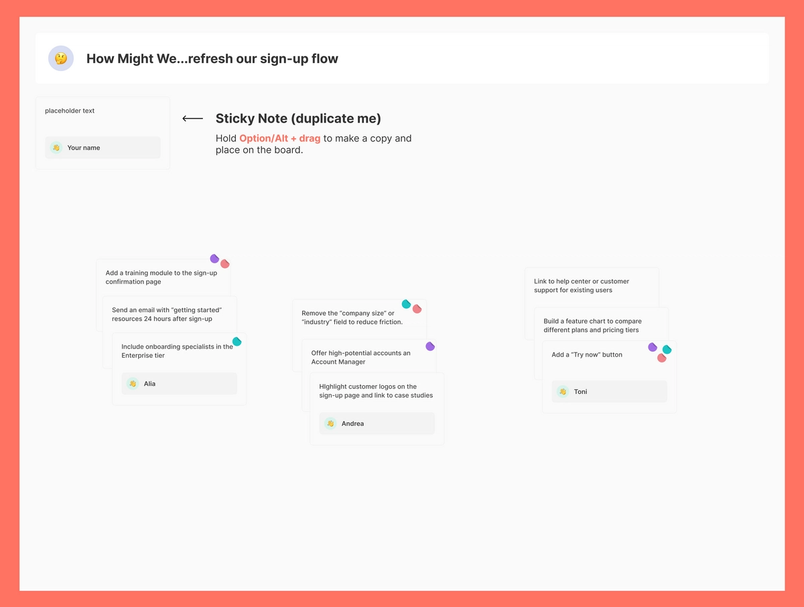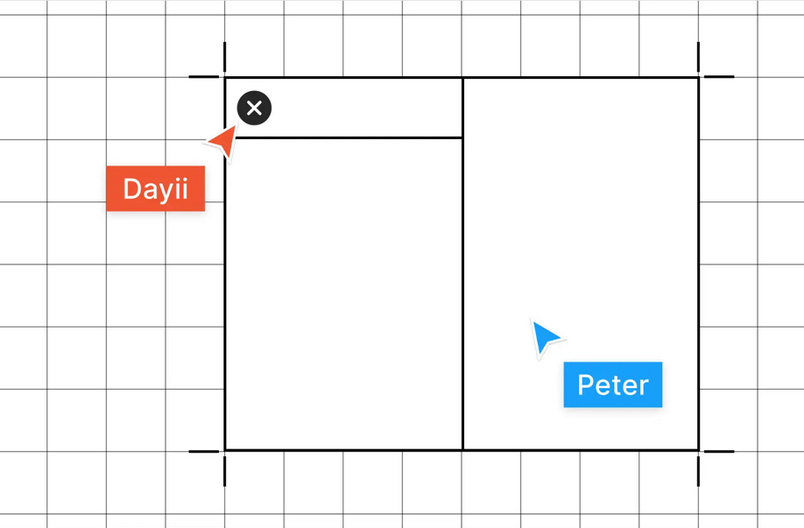How to run a remote brainstorm


The Figma team has been working remotely for a couple weeks now, and we’re still adjusting to our new normal. Here, we share tips for running a remote brainstorm, based on what’s working well for us.
There’s a lot happening in the world right now, and we have to acknowledge that things aren’t business as usual. While the main goal certainly isn’t maximum productivity, the reality is that many of us—ourselves included!—are still doing work, attempting to find a rhythm in our new (temporary) normal. So, we at Figma have been exploring ways to make that adjustment a little easier.
We’ve all been working from home for the past few weeks now, and we’ve been thinking a lot about how to translate the moments that happen in the office to an entirely-remote workforce. It has long been a habit of ours to add a dial-in for our remote colleagues, but we’re not used to a fully-dispersed team. Now that it’s no longer an option to have a quick huddle or whiteboard in a conference room, we’re realizing how challenging it is to run an effective brainstorm (and how frustrating it can sometimes be for our always-remote colleagues).
Brainstorming at Figma
We’re lucky that we have a very open, collaborative culture here at Figma. Many of us seek out feedback from our coworkers on all sorts of topics, whether it’s exploring different product directions or fielding ideas for new blog posts. Brainstorms can mean a lot of things. Broadly, we turn to them when we need to hear from different perspectives, riff on concepts with a wider audience, or build out an idea into something more substantial.
Compared to more transactional meetings focused on updates and check-ins, brainstorms require different energy. While they’re not always about creative concepts, they often ask participants to dream up original ideas. That can be tough to do, especially during such an uncertain time. Below, we’re sharing what we’ve learned as we try to keep our brainstorms structured and efficient, while giving our team the space to think creatively.
Getting ready
Like any other brainstorm, a little prep work will help you get the most out of your time together. Just remember that you might need to pay more attention to the logistical details—when the whole team is remote, it’s particularly important to make sure everyone’s on the same page.
Outline goals
Ask yourself what you’d like to get out of the brainstorm, keeping in mind the phase your project is in. Are you looking to get as many new ideas as possible, or do you need help refining a couple different options? Being clear about your goal will help your teammates understand what level of concepts you need.
Get your tools ready to go
In the office, you can find people at their desks or quickly bounce ideas around in a conference room. As we get used to working from home, we’re realizing how much more we’re relying on our tool ecosystem. Here’s a quick checklist:
- Video conferencing: Include a link to a VC call in the meeting invite. While everyone can technically dial in by phone or hide their video, encourage the group to turn on their cameras. Getting a little face time can make everyone feel more connected and open to throwing out new ideas. Plus, we’ve been having a lot of fun with Zoom's Virtual Background feature, which allows you to choose an image or video as your background.
- Figma file: In Figma, you can create one central home for everyone to work off of (while this one is technically for a full design sprint, it’s a great place to start). Make a file (like this one) specifically for the brainstorming session and give everyone in the meeting edit access. You can make as many pages as you need within that file. Or, you can create multiple frames to house ideas that fall into different themes.
- Chat: If it’s an ongoing workstream, consider creating a Slack channel. Beyond sending meeting notes and keeping the team up to date, you can ask the team for ad hoc feedback and input. Pro tip: paste the link to the working doc in the channel’s “topic” field so everyone can easily find it.
Send the file in advance
Some people work better when they have time to reflect on the task, instead of doing it live. Send the file the night before or morning-of with a brief description of what you’re hoping to accomplish. If you have ideas for the team to react to or build on, make sure to flesh those out in the doc. Encourage teammates to ping you directly or comment in the file with questions.
Running a remote brainstorm
Kick things off
By this point, you’ve already shared goals and initial thinking with the team. As a quick refresher, or for anyone who hasn’t gotten around to reviewing your materials, remind the group what you’re looking for and how they can help. During the session, it’s possible—likely, in fact—that the group will veer off course at some point. It’s usually a good sign that they’re excited about what you’re talking about! To get things back on track, create a “Parking lot” within your document and direct everyone to write down ideas there that aren’t directly relevant to the conversation, but are worth exploring at a later date.
Run an exercise
Freeform sessions certainly work, but we’ve found that more structured brainstorms are better when everyone’s remote. If you’re running the session over VC, consider having participants break out into teams of 2-3. Some people are more inclined to chime in when they’re not in a big group, and it’s easier to handle potential technical or communication issues in a smaller forum. Here’s what that looks like in practice, based on a brainstorm our Product Marketing team ran last week:
- Join the Zoom and share your screen with the Figma file (or ask the team to follow along in Observation mode).
- Have everyone opt into small groups of 2-3 (some VC tools like Zoom have a "breakout" feature).
- Ask each group to designate a “lead” who will share takeaways with the broader group.
- If you’re just trying to get as many ideas as possible, ask everyone to create a post-it note for each unique idea. If you’re looking to riff on existing concepts, instruct them to comment directly on the file.
- Set a 10-min timer. Remind everyone to re-join the group when they’re ready.
- Call on each group to present, and make sure to take notes on the central file. Let everyone know that they can +1 ideas with dot stickers.

Follow up
It’s hard to capture everything in the file when you’re also trying to run the meeting and listen, so make sure you spend the half hour or so following the meeting organizing your notes and collating feedback. If you’ve created a Slack channel for the group, use it as a home for meeting notes and next steps.
Go easy on yourselves
More than ever, it can be hard to be creative. Know that it may take more time and space than usual to land on the right direction—don’t force it.
Plus, it doesn’t have to be formal. If you’re not feeling a scheduled brainstorm, or if you’re just looking for a creative outlet, you can all hop in the same file and have some fun.
You can check out more on all things remote design here. We’d also love to hear from you—give us a shout on Twitter to let us know what has worked for you and the types of resources you’d like to see from us.

Alia Fite is a writer and editor on Figma's Content & Editorial team. She has previous experience at Stripe and Dropbox.



